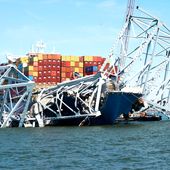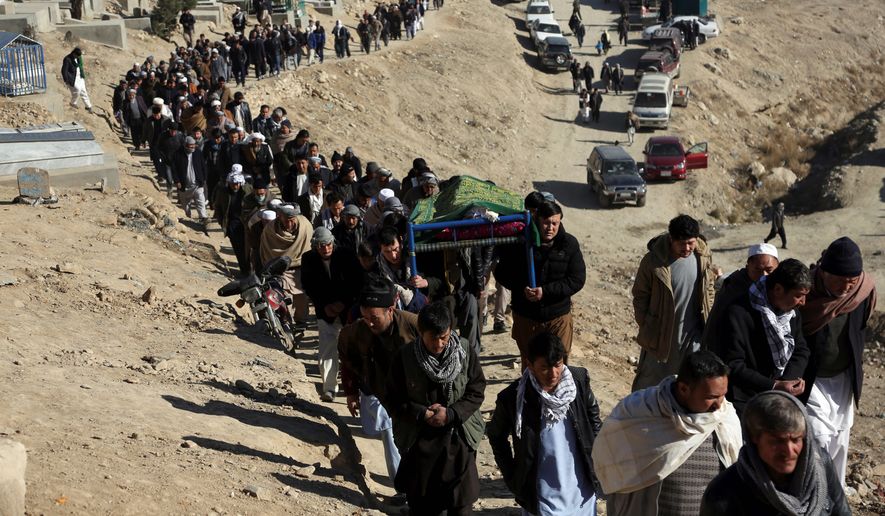Its vaunted “caliphate” is in shambles, but the brutal legacy of the Islamic State is only now coming into clearer focus as rebuilding efforts across Iraq and Syria uncover hundreds of mass graves and fully pull back the curtain on four years of death, destruction and unspeakable atrocities by the radical Islamist terrorist group.
The United Nations Assistance Mission for Iraq revealed this month that it has uncovered evidence of more than 200 mass graves containing as many as 12,000 victims in northern and western Iraq, though Iraqi officials say the number could be even higher. The existence of the gruesome sites could only recently be confirmed, as a U.S.-led military coalition pushes the terrorist group — also known as ISIS — out of the territory it once claimed.
U.N. observers and regional specialists also are urging a seemingly reluctant Iraqi government to commit to exhuming all of the mass graves, identifying the dead as best they can, and documenting in detail the carnage that took place.
At the same time, areas across Iraq and Syria ravaged by years of fighting are now discovering that crucial infrastructure such as hospitals and water supplies have been badly damaged. The U.N. and other international groups are trying to rebuild that infrastructure as civilians displaced by war, or who fled to escape the Islamic State’s violent reign, return home.
But it’s the human death toll, specialists say, that will define the Islamic State in history books.
Mass killings of women, children, Christians, Shia Muslims, Yazidis and other groups in areas ruled for years by Islamic State militants are considered by many observers to be an all-out genocide, and anecdotal accounts of the sheer brutality, including beheadings, shootings, and burning and burying victims alive, still have the capacity to shock.
The violence had faded off front pages and out of many Americans’ minds as the Islamic State was militarily defeated, analysts say, but now will be back at the international spotlight as fresh evidence comes to light and the size of the rebuilding effort to come becomes clearer.
“Americans have shifted away from ISIS to other areas, whether it’s China, Russia, North Korea, Iran or other places,” said Seth Jones, director of the Transnational Threats Project at the Center for Strategic and International Studies. “I think Americans honestly have quickly forgotten with the loss of territory in Iraq and Syria just how terrible they were as an organization.”
The carnage includes “the mass killings they committed in Fallujah and Ramadi and Raqqa, and a range of areas in eastern Syria, western and northern Iraq, mass graves, and just generally how they treated individuals,” he continued. “For ISIS, essentially anybody who does not have the same beliefs … are all enemies and groups that deserve to be killed. They’re open game. They’re all infidels. It’s that mentality as they go through areas, if it’s possible, if it’s not out of the way, they will kill in large numbers.”
In its report, U.N. investigators said that there may be many more mass graves than just the 202 identified in parts of Iraq once controlled by the Islamic State. The study referred to the group’s actions as “acts that may amount to war crimes, crimes against humanity, and possible genocide.”
The Islamic State’s campaign of killing continued across Syria and Iraq from 2014 to the end of last year. While there were numerous horrific incidents, one of the most notable was the so-called Camp Speicher Massacre in June 2014, where Islamic State fighters murdered more than 1,700 Shia Iraqi Air Force cadets in Tikrit.
Nearly 30,000 civilians have been killed in areas once controlled by ISIS in Iraq, the U.N. said, though it stressed that “these figures should be considered an absolute minimum” and do not include military personnel such as those slaughtered at Camp Speicher.
‘The magnitude of rebuilding’
While the areas have mostly been cleared of Islamic State fighters — the group, the Defense Department says, is transforming from a fighting army into a more covert terrorist network that’s less interested in holding physical territory — U.S. and international observers say the conditions remain poor. In Syria, an ongoing civil war has made it difficult to rebuild homes, schools, hospitals and infrastructure.
In Iraq, the Pentagon says the government in Baghdad is still unable to handle the number of “internally displayed persons,” or IDPs, trying to return home.
“The government of Iraq continues to be unable to provide adequate services and support to the IDP community, and international organizations lack the capacity and resources to fill the gaps,” the Defense Department inspector general said in a recent report. “Insecurity, retaliation against those suspected of having ISIS affiliations, and the magnitude of rebuilding needed in conflict-damaged areas continued as obstacles to the permanent return of IDPs.”
Across Iraq and Syria, the process of rebuilding has been painfully slow. The bulk of Syria is under the control of Syrian President Bashar Assad and his Iranian and Russian allies, and international talks on rebuilding the country after seven years of brutal civil war have barely begun.
In areas where the U.S. and coalition allies in Iraq and Syria operated, the most significant damage to infrastructure, analysts say, resulted from intense ground combat campaigns to free cities such as Fallujah from the grip of the Islamic State.
In Fallujah and elsewhere in Iraq’s Anbar Province, the World Health Organization recently launched an effort to provide emergency health care and ambulance services to areas that saw most of their medical facilities destroyed.
“In 2017, more than half of Anbar’s health infrastructure, including hospitals in Ana, Al-Qaim, Rawa, and Al-Obaidy were either looted and/or destroyed,” the U.N. said in a statement announcing the WHO initiative. “As a result, many departments in this hospital and three other hospitals remain closed and more resources are required to reopen them.”
The U.S. Agency for International Development and Office of U.S. Foreign Disaster Assistance funded the Anbar health care initiative.
A full accounting
Rebuilding infrastructure is a mammoth task, but analysts say it’s proving equally difficult to properly identify and map the locations of mass graves across Iraq. U.N. officials and human rights advocates are publicly admonishing the Iraqi government to make exhumations, identifications, and a full accounting of the Islamic State’s bloodshed a top priority.
So far, however, specialists say the issue isn’t getting the attention and resources it deserves.
“There’s really fundamentally no interest in that,” said Belkis Wille, senior Iraq researcher with Human Rights Watch. “In Iraq, the issue of exhumation of mass graves is so heavily politicized. There’s infighting between different people on who will take the lead on doing the exhumations, and certain mass graves are being prioritized over others based on who is thought to be in the ground.”
The Iraqi government, Ms. Wille added, remains focused on rooting out the last remnants of the Islamic State, putting them on public trial, and meting out punishment. A thorough, robust effort to fully document the atrocities likely would reveal a death toll that’s far higher than current estimates, she said.
“There are certain mass grave sites very well known because of the size,” Ms. Wille said. “There are definitely graves — three or four people — even in cities like Mosul where there hasn’t been a proper mapping done. … I would not be surprised if what we end up with is a much higher number, but that would require dedication to a mapping strategy.”
The U.N. has raised similar concerns. One secondary motivation of its report appears to be sending a public message to the Iraqi government.
“It is critical that the integrity of mass grave sites be maintained as they potentially contain significant sources of evidence which can be used for criminal prosecutions,” the report states.
Beyond criminal prosecutions and an accurate historical record, U.N. officials also say that there’s an even more important motivation to fully map and exhume each mass grave across Iraq.
“These graves contain the remains of those mercilessly killed for not conforming to [the Islamic State’s] twisted ideology and rule, including ethnic and religious minorities,” said U.N. High Commissioner for Human Rights Michelle Bachelet. “Their families have the right to know what happened to their loved ones. Truth, justice and reparations are critical to ensuring a full reckoning for the atrocities committed by ISIL.”
Iraqi officials maintain they’re committed to the issue and believe they have a handle on the number of graves and victims.
“I can only say that the number of the victims of the mass graves is much bigger than the numbers in the report,” Dhia Kareem, head of the Mass Graves Directorate in Iraq, told The New York Times this month.
• Ben Wolfgang can be reached at bwolfgang@washingtontimes.com.




Please read our comment policy before commenting.